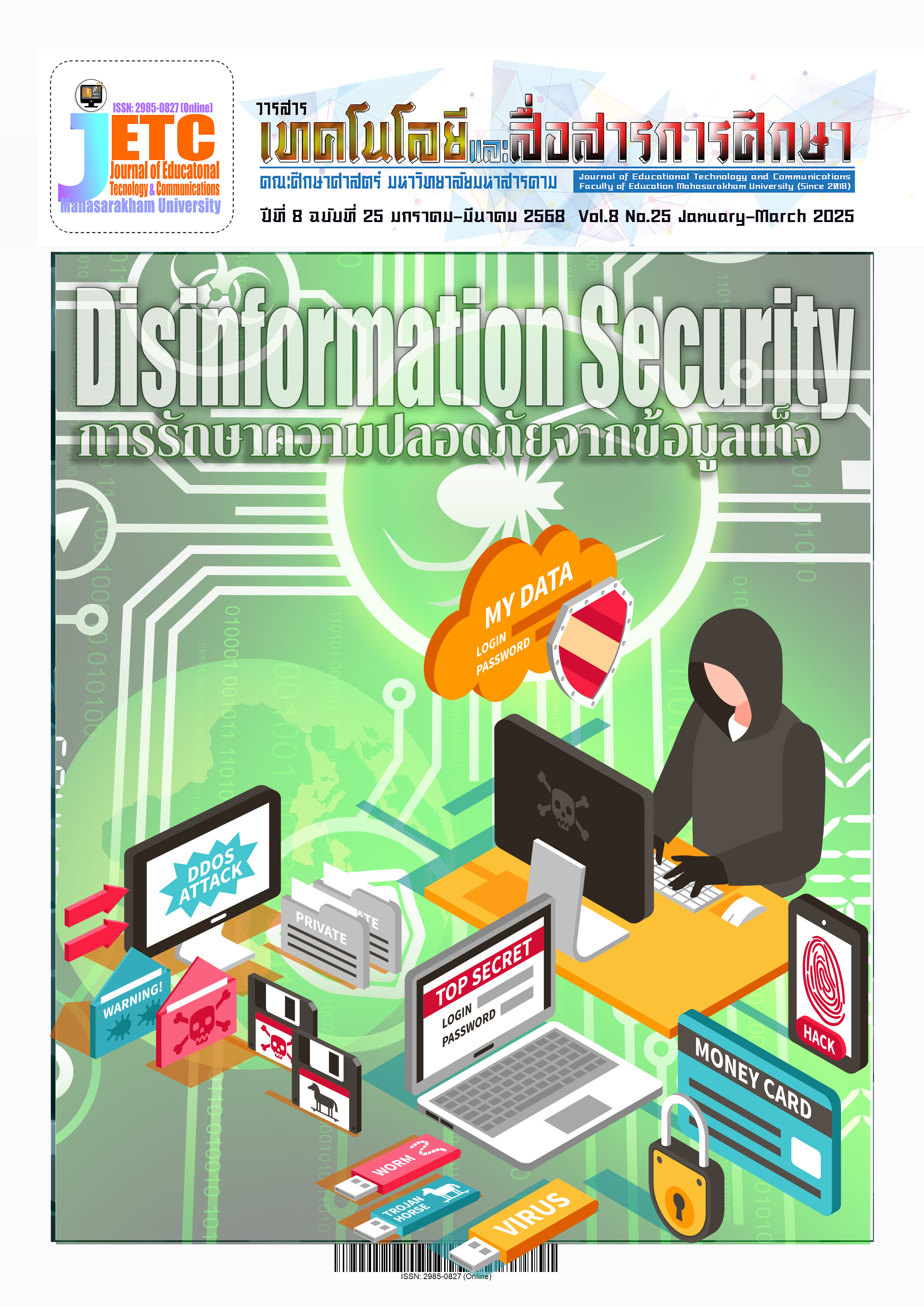Evaluation of Project to Enhance Morality and Ethics in Educational Institution Using the CIPPIEST Model, Bannongtaphon Mittrapab No. 5th Municipal School
Main Article Content
Abstract
The purpose of this study were to evaluate the suitability and productivity of the project, as well as to examine guidelines for its implementation in enhancing morality and ethics in educational institutions at Bannongtaphon Mittrapab No. 5th Municipal School. The target group was 40 teachers and educational personnel by purposive selection. A suitability assessment form was used in the first step. The sample group consisted of 152 students selected through simple random sampling based on Krejcie & Morgan’s table, along with 152 parents corresponding to the student participants. A questionnaire was used in the second step. The data were analyzed using mean and standard deviation calculations.
The evaluation results indicated that the project’s overall implementation met the evaluation criteria. It was appropriate at a high level. (=4.47,
=.160). Evaluation of the results of the project to promote morality and ethics in educational institutions from the students who participated in the project, they passed the evaluation criteria at a high level (
=4.15, S.D.=.250). From parents of students participating in the project, they passed the evaluation criteria at a high level (
=4.12, S.D.=.271). And a study of the guidelines for implementing a project to enhance morality and ethics in educational institutions find that there should be a plan for implementing the project that was consistent with the policy to enhance morality and ethics, continuously carried out the project every year, prepared teachers and educational personnel lecturer who gives knowledge materials, equipment and buildings were ready, defined roles and responsibilities for planning operations, supervising, monitoring, and evaluating after the end of activities and reported performance results to relevant people used the findings to make improvements, published and expanded the results to the community by applying the knowledge gained effectively. Students demonstrated improved behaviors in gratitude, discipline, honesty, self-sufficiency, and volunteerism. They also served as role models and shared their knowledge with peers, families and communities. Continuous monitoring and reporting of the project’s outcomes were recommended for sustainable implementation in the following years.
Downloads
Article Details
References
คณะกรรมการการศึกษาขั้นพื้นฐาน, สำนักงาน. (2560). แนวทางการขับเคลื่อนโครงการโรงเรียนคุณธรรม สพฐ. ประจำปีงบประมาณ พ.ศ. 2560. คณะกรรมการการศึกษาขั้นพื้นฐาน.
ชำเลือง วุฒิจันทร์. (2554). ปัจจัยที่มีอิทธิพลต่อการปลูกฝังคุณธรรม. การศาสนา.
ทิวัฒน์ มณีโชติ. (2561). รูปแบบการประเมินโครงการ ในการประเมินโครงการ หน่วยที่ 1–7 (พิมพ์ครั้งที่ 6). โรงพิมพ์มหาวิทยาลัยสุโขทัยธรรมาธิราช.
ธัญลักษณ์ ชูศรีโฉม และธีระพงศ์ บุศรากูล. (2564). แนวทางการจัดการส่งเสริมคุณธรรมจริยธรรมแก่นักเรียนของโรงเรียนในสังกัดสำนักงานเขตพื้นที่การศึกษาประถมศึกษาสมุทรสาคร. วารสารวไลยอลงกรณ์ปริทัศน์ มนุษยศาสตร์และสังคมศาสตร์). 11(1), 49-62. https://so06.tci-thaijo.org/index.php/var/article/view/244020
บุญชม ศรีสะอาด. (2560). การวิจัยเบื้องต้น. (พิมพ์ครั้งที่ 10). สุวีริยาสาส์น.
พิชิต ฤทธิ์จรูญ. (2562). เทคนิคการประเมินโครงการ: แนวคิดและการประยุกต์ใช้. ศูนย์หนังสือจุฬา.
มนิดา เจริญภูมิ. (2559). การประเมินโครงการพัฒนาคุณธรรม จริยธรรมของนักเรียนโรงเรียนแวงน้อยศึกษา สังกัดสำนักงานเขตพื้นที่การศึกษามัธยมศึกษา เขต 25. [วิทยานิพนธ์ปริญญามหาบัณฑิต, ไม่ได้ตีพิมพ์]. มหาวิทยาลัยราชภัฏมหาสารคาม.
มินตรา สมจิตต์ ศิริชัย กาญจนวาสี และโชติกา ภาษีผล. (2567). การใช้แบบจําลอง CIPP และแนวคิดที่คลาดเคลื่อนในการนําแบบจําลอง CIPP มาใช้ในการประเมินโครงการทางการศึกษา. วารสารการวัด ประเมินผล สถิติ และการวิจัยทางสังคมศาสตร์. 5(2), 38-52. https://so03.tci-thaijo.org/index.php/mesr/article/view/275105
รัตนะ บัวสนธ์. (2556). รูปแบบการประเมิน CIPP และ CIPPIEST มโนทัศน์ที่คาดเคลื่อนและถูกต้องในการใช้. วารสารศิลปากร ศึกษาศาสตร์วิจัย. 5(2), 7-24. https://so05.tci-thaijo.org/index.php/suedureasearchjournal/article/view/257105
เลขาธิการสภาการศึกษา, สำนักงาน. (2560). แผนการศึกษาแห่งชาติ พ.ศ. 2560–2579. บริษัท พริกหวานกราฟฟิค จำกัด.
วรัชยา ประจำ. (2564). การประเมินโครงการส่งเสริมคุณธรรมจริยธรรมนักเรียนในโรงเรียนคุณธรรม สพฐ. โรงเรียนอนุบาลห้วยทับทันโดยใช้ CIPP Model. วารสารวิชาการมหาวิทยาลัยราชภัฏศรีสะเกษ. 15(3), 102-123. https://so05.tci-thaijo.org/index.php/sskrujournal/article/view/252452
ศิลชัย ถาวร. (2565). การประเมินโครงการพัฒนาคุณธรรมจริยธรรม ของโรงเรียนรัตนโกสินทร์สมโภชบวรนิเวศ ศาลายาในพระสังฆราชูปถัมภ์. [การค้นคว้าอิสระปริญญามหาบัณฑิต, ไม่ได้ตีพิมพ์]. มหาวิทยาลัยศิลปากร.
ศูนย์คุณธรรม (องค์การมหาชน). (2556). มาตรฐานโรงเรียนคุณธรรม. ศูนย์คุณธรรม (องค์การมหาชน).
ศูนย์โรงเรียนคุณธรรม มูลนิธิยุวสถิรคุณ. (2558). คู่มือปฏิบัติโรงเรียนคุณธรรม. บริษัท สหมิตรพริ้นติ้งแอนด์พับลิสซิ่ง จำกัด.
Krejcie, R. V., & Morgan, D. W. (1970). Determining sample size for research activities. Educational and Psychological Measurement. 30(3), 607–610.
Stufflebeam, D. L. & Shinkfield, A. J. (2007). The Spirit of Consuelo: An Evaluation of Ke Aka Ho’ona. Kalamazoo.
Stufflebeam, D., Gullickson, L. A. & Wingate L. (2002). The Spirit of Consuelo: An Evaluation of Ke Aka Hoona. The Evaluation Center, Western Michigan University.
Stufflebeam, D.L. (1997). Educational evaluation and decision making. Peacock Publishers, Inc.

